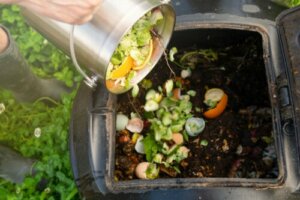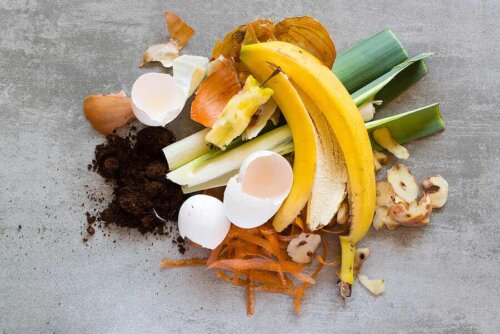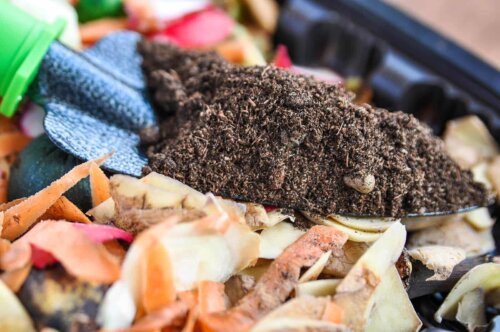How to Make Your Own Compost at Home

Compost is a natural process through which we can reuse organic waste. This is because it transforms into a fertilizer that we can use to nourish our garden or plants. Keep reading this article to find out how to make your own compost at home and what the benefits are!
Organic material accumulates in compost as it decomposes with the help of microorganisms and animals. Due to the fact it’s natural, it’s an economic technique for agriculture activities.
To make sure your compost is successful, it needs to stay in a ventilated, damp space that has a neutral temperature. Some items are great for this kind of fertilizer; things like remnants of fruit or vegetables, eggshells, and general garden waste.
The benefits of making your own compost
A large part of domestic waste contains organic residue that can take a while to decompose in a landfill in addition to producing methane gas and contribute to global warming. However, compost aims to ensure that such organic matter doesn’t reach that destination and that it helps the plants in your garden.
This helps to counteract the effects of environmental contamination because we no longer throw that waste into landfills – we can take advantage of it at home! Also, it’s a great option for making natural fertilizer and it helps you to avoid using fertilizers and insecticides that contain harmful chemicals.
This process offers multiple benefits in the natural habitat of the home. With compost, you’re able to obtain a more fertile soil and keep it damp so that plants get nutrients and grow healthily.
Similarly, it reduces the risk of soil fragmentation and favors the presence of microorganisms that eliminate toxic substances for the environment and plants.

What you need to make your own compost
Composting is a process that all homes can benefit from because you don’t need sophisticated tools to do it. Below, we explain what you’ll need to get this fertilizer we call compost.
Keep reading: France Bans Food Waste in Supermarkets
Organic food waste
The most important thing for compost is organic waste because this is what decomposes and helps create fertilizer.
You can use certain food waste items to make compost, such as eggshells, leftover fruit, vegetables, beans, and coffee and tea waste. These contain nitrogen which helps accelerate the rate of decomposition.
Garden waste
You can use garden waste, such as general pruning waste, branches, and dry plant leaves. These contain carbon, which helps to create a layer of topsoil that helps strengthen the soil and keep it damp.
Other organic waste that you can use
During the composting process, you can also add wood, paper, or cardboard waste as these also contain carbon.
Products that aren’t suitable for composting
You cant compost oil, meat, fish, lactose, bread, or egg yolk waste. This is because they tend to generate a bad smell and can cause rodents or infestations that can damage the process.
Also, you can’t compost plant waste that’s in a bad state as it may have harmful fungus.
Use a composter
This is a container that you’ll use to store the organic waste and create compost. You can find plastic, wooden, or metal containers in the supermarket, although we recommend you go with the first kind because they’re more durable.
They usually come with an opening at the top where you can deposit any organic waste you’ve accumulated. Also, on the sides, there should be another access point which is where you’ll take the natural fertilizer from when it’s ready.
You should put the composer somewhere where it has access to a lot of air and is always damp.
Leaf rake
This is a tool that people use exclusively for agricultural activities. It’s similar to a broom and it just collects leaves and grass that have fallen, helping you keep your space firm and refined.
It’s an essential tool for composting because it helps you collect all the leaves, branches, and crop waste that will be useful to create the natural fertilizer.
Garden bags
You can store leaves and grass in these. You can separate dry and wet waste when composting, which will help you when you go to put it in the composter.
Step-by-step to make your own compost
Composting is an effective and simple process that you can do at home. By following these 7 steps you’ll be able to get natural compost and a lot of nutrients.
1. Choose which organic waste you’ll compost
The first step is choosing the compostable food and garden waste that you have at home. When it comes to food waste, it’s important to check that they don’t contain any kind of fat or cooked ingredients.
2. Separate them
After selecting which organic waste is suitable, put them in a container. This helps you to keep them separate from the general trash and organize them for when you’ll be able to put them in the composter.
3. Choose the place
You should have already bought your composter, and have chosen where it’ll go. This step is very important because the space has to have suitable air, temperature, and humidity conditions.
4. Start gathering waste
You need to organize the organic waste by layers. First of all, you should put down a good load of thicker materials like leaves and branches, as they can help aerate the compost.
Secondly, add fruit, vegetable, and legume waste. This will start to help the carbon and nitrogen levels.
After, on the third layer, add already-made fertilizer, because this can also help with decomposing the other elements.
5. Continue adding waste to make your own compost
You should continue adding waste in layers. It’s important that you add more wet waste to help speed up the decomposition.

6. Irrigate and stir your own compost
It’s essential that you wet the layers of waste with a little bit of water to help keep it damp. However, don’t excessively water it because you can damage the compost by soaking it.
Similarly, you must stir the waste now and then to help aerate it.
7. Extract the fertilizer in a few months
With a constant process, you can start to use the natural fertilizer to feed your plants in about 6 months. Compost that’s ready has an earthy smell and doesn’t smell bad.
Discover: 12 Recommendations to Make a More Sustainable Home
Environmental conditions and making your own compost
The process will only be successful if the waste stays in damp, well-aerated conditions in neutral temperatures. The properties of the specific elements and the distribution of the layers help with these characteristics, but it’s also essential that you help to keep it fresh with watering and ventilation.
Making your own compost is a commitment because if you let it become damaged, there’s no way to recuperate it. Start today and create the ideal conditions to help the planet!
All cited sources were thoroughly reviewed by our team to ensure their quality, reliability, currency, and validity. The bibliography of this article was considered reliable and of academic or scientific accuracy.
- Román P. Martínez M. Pantoja P. Manual de compostaje del agricultor, experiencias en América Latina [Internet]. Santiago de Chile: Organización de las Naciones Unidas para la Alimentación y la Agricultura; 2013 [citado 23 de marzo de 2021]
- Barrena R. Compostaje de residuos sólidos orgánicos. Aplicación de técnicas respirométricas en el seguimiento del proceso [Internet]. Barcelona: Departament d’ Enginyeria Química de la Universitat Autónoma de Barcelona; 2006 [citado 23 de marzo de 2021]
- Márquez P. Díaz M. Cabrera F. Factores que afectan al proceso de Compostaje [Internet]. España: (S.E); (S.F) [citado 23 de marzo de 2021]
This text is provided for informational purposes only and does not replace consultation with a professional. If in doubt, consult your specialist.








